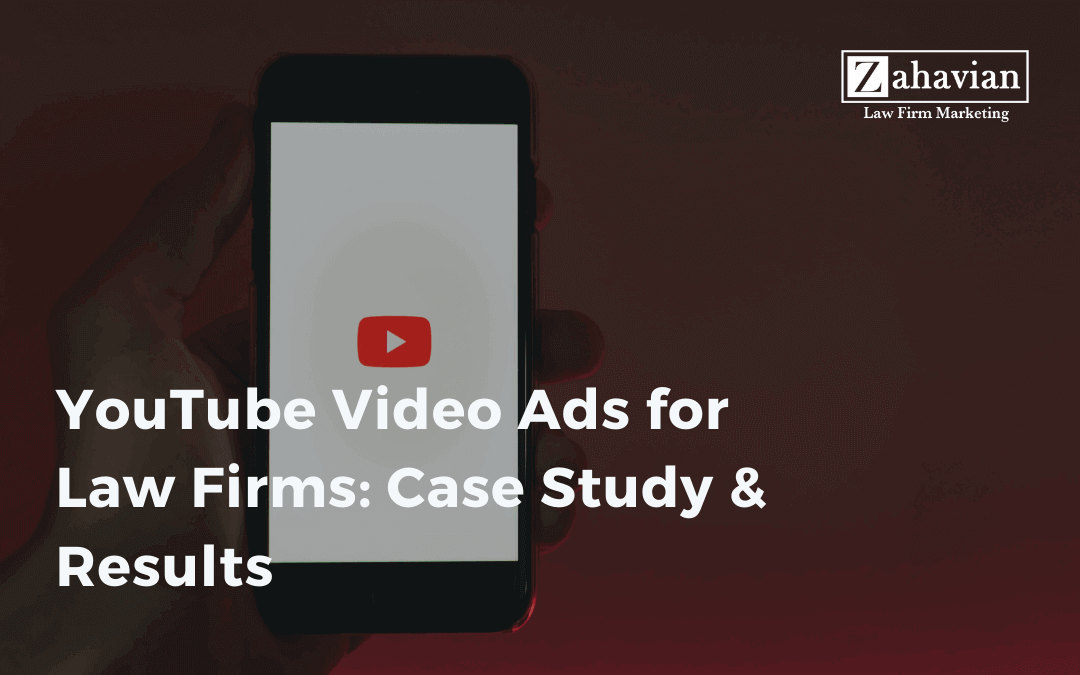YouTube ads are an effective way for many businesses in a variety of consumer and business facing industries to acquire new business. Law Firms for personal injury and insurance cases have traditionally relied TV commercials to attract new clients and increase their files.
Problem
A small law firm of 6 lawyers was looking to increase their personal injury case intakes was seeking to advertise across different online mediums. Their TV commercials proved effective before, however were limited by a minimum advertising budget.
Their TV commercials were also being aired by a network that broadcasted in regions where their firm didn’t practice law or market to. This meant cases that some their leads were unqualified due to geographical issues.
Solution
Zahavian Legal Marketing took their existing TV commercials and advertised them via YouTube. This allowed them to target specific areas, cities and demographics that made up their ideal client persona. Through using YouTube, Zahavian was able to exclude content, channels and times of day which were not ideal for attracting new business for the firm.
Ad Creative
Two videos were used for the ad. One was a standard 15-second commercial that the firm had previously aired on TV and the other was a 60 second commercial with a firm overview and monologue from the managing partner.
Delivery & Schedule
The Ad Campaign lasted for 3 weeks. The Ads were displayed across YouTube channels and videos without profanity and available for most audiences. The segment of the market targeted included adults 30 and up.
However, one caveat to recent changes made on the YouTube platform meant that careful programmatic and manual monitoring had to be used to ensure proper ad placements. The reason for this being is that adults 30 and up, included parents and grandparents lending their phone to their children to watch YouTube or play games on. Learn more about this problem in this post on comparing YouTube to other PPC platforms.
Results
Through Advertising on YouTube, the firm achieved the following metrics:
| Ad | CPV | Impressions | Conversion Rate | Cost per Lead |
| 60-seconds | $0.05 | 113.1k | 23.08% | $33.72 |
| 15-seconds | $0.04 | 76.9k | 4% | $75.81 |
| Overall | $0.05 | 190k | 12.5% | $38.98 |
Other important metrics that were discovered through the video campaign were included:
- 195% increase in Goal Conversion Rate over other online paid ad channels. When looking at the metrics in Google Analytics, the YouTube ad campaign performed at a CVR of 12.5% compared to the average rate of 6.4% across all other channels.
- 774% Return on Investment of Ad Spend vs Lead Value
- An Average CPV (Cost-per-View) of $0.05. The CPV was lower for the 15-second commercial than the 60-second commercial. However, this metric takes a back seat to others seeing that the 60-second commercial yielded many more leads and a cost per lead of nearly half of the 15-second commercial.
- 87% of all tracked leads were from the 60-second commercial. That boils down to about 7 in 8 leads were from 60-second commercial vs the 15-second ad that was previously used on TV.
- 21% lower Bounce Rate from the 60-second commercial vs the 15-second commercial. This is coherent seeing that many more clicks from the longer ad outperformed the shorter ad in terms of leads and conversion rate.
Next Campaign Iteration
The 60-second ad performed very well and will be used without change in another round of the same campaign. The 15-second commercial did not perform as well. However, there are several hypotheses for that.
Addressing Potential Issues
While the campaign yielded promising results, there is always room for improvement. One way to increase leads without changing budget or ad spend, is to cull the shorter, 15-second video ad that underperformed.
This produces a quick and efficient solution for generating more leads at a lower cost and making our client happier with the result. However, good marketing requires acting on the data. In order to do so, there must be enough data to act upon.
One Campaign does not suffice. Only the two ads ran. One was a clear winner while the other was not. However, before culling the losing video ad, there are variables we could hypothesize and test before ruling it out.
2 hypotheses that were produced for the underperforming ad were:
- The Ad Creative wasn’t a good fit for the platform
- The Ad Requires tuning the Funnel in order to increase conversions
Potential Issue #1: Ad Is Not a Good Fit for YouTube
The first potential issue is that the 15-second commercial is dated and doesn’t mesh well with YouTube’s audience. The ad does stand out and likely not in a positive manner. Many factors, from the hook and pitch made in the commercial to the music jingle in the background give off red flags.
Potential Issue #2: Requires Funnel Adjustments
Upon comparing the videos, the shorter ad focused on a particular sub-category of personal injury cases, while the longer video discussed a more broad set of case types. However, both ads directed traffic to the same landing page. While it was more effective for the longer ad, the more specific ad may need a special page dedicated to the ad’s messaging to reduce its bounce rate and increase conversions.
The next campaign will test out the shorter, 15-second commercial again. However, significant changes must be made to the overall funnel.


